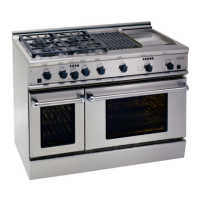UNPACKING AND HANDLING
7
MOVING AND PLACING THE RANGE
Electric and gas connections should be made
before the range is slid into the cabinet opening
(see page 13 & 14).If installing a full backguard with
the range, it should also be installed before the
range is placed in its final position (refer to page 5).
For proper performance, the professional range
should be level. To achieve a flush fit of the range
to adjoining countertops, it will be necessary to
have level cabinets (front to back, and left to right
across opening of the range). After checking the
countertops for level and before sliding the range
into place, measure the distance from the floor to
the top of the counter work surface in the rear left
and right corners. Adjust the corresponding rear
corner of the range to an equal height of the
counter, as the rear leveling legs are not accessible
once the range is pushed into place. Once the
range is in place, the front leg levelers can be
accessed to level the front of the range. Replace
the kick panel and oven doors by reversing the
procedure described previously. It is important
that the two screws retaining the kick panel are
secure to prevent accidental access to live electrical
components and wires (fig. 1).
GRIDDLE AND GRILL LEVEL ADJUSTMENTS
The grill and griddle sections (if equipped) are
fastened in place at the front with screws. They are
designed to be stationary and not meant to be
removed for cleaning. The griddle has two leveling
screws beneath the rear flue cover which can be
used to adjust the griddle to the desired slope. To
access the leveling adjustment screws, remove the
griddle flue cover by lifting upwards. The center
screw is for shipping and should be removed.
Fig. 4
Fig. 5
Shipping Screw
(remove)
Lock
(close)
Unlock
Outer Leveling
Screws (2)
Griddle Flue
Cover

